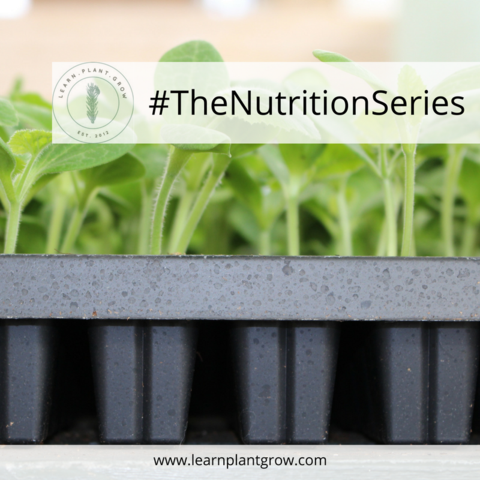Secondary and Tertiary Macronutrients
Part 4: #TheNutritionSeries
This post was co-authored by my awesome husband Tanner Pollack. Tanner’s background is agronomy (the science of growing crops) with a focus on crop production. He runs an agronomy consulting business and farms in Northern Alberta.
During our last post we explored Nitrogen (N), Phosphorus (P), and Potassium (K). In this blog we’re going to check out sulphur, calcium, and magnesium. They’re needed in fairly large amounts by our plants, but are considered secondary because they’re needed in less quantities then N, P, and K.

Sulphur
Sulphur (S) performs a lots of roles in the plant. It really complements nitrogen, because it’s needed for building amino acids and proteins. Remember when we talked about peas and beans being able to fix their own nitrogen? Well, sulphur is a critical part of the enzyme that does that! Unlike nitrogen, S is not mobile in the plant; the plant cannot take S from old leaves and re-use it in new leaves.
Most of your gardens are probably ok for sulphur. If you use manure or compost, you will be adding S as a part of that material. This should be ok for most of the plants you are growing. Some of your vegetables may require more S though, such as the cruciferous vegetables (cabbage, kale, broccoli, etc.). Pungent vegetables – I’m looking at you, onions and garlic – also have a bit higher S requirements. Some of your garden flowers may need a bit of S added as well; check out the newest growth. If the newest leaves are a bit less green, or the flowers a bit pale in color, you might need to add a little S fertilizer. A good balanced garden fertilizer used in-season will provide some S.
One of the neat things about sulphur is we can use it in elemental form to fertilize; added at a high enough rate, this elemental S fertilizer can lower soil pH (acidify the soil). Some crops, such as blueberries, actually do much better in acidic soils!
Calcium
Calcium (Ca) is one of the most abundant nutrients in the soil, and is very important for plants. Calcium acts as a transporter in plants (similar to K), and is a part of many different enzymes in plants. Similar to sulphur, Ca is not mobile in the plant; it is tied in in plant structures, especially cell walls. Calcium is also needed for growth, so it tends to accumulate at growing points in the roots and shoots. This is why calcium deficiencies present as stunted, deformed growth in most plants. One example of calcium deficiency that most gardeners are familiar with is blossom end rot in tomatoes.
As mentioned above, calcium is abundant in our soils. However, soil pH (acidity) can greatly impact how available the calcium is in the soil. If you suspect you may have a calcium deficiency, take a soil test! Low pH soils (under pH 6) are acidic; calcium wants to stay bound to clays and other minerals in the soil. Conversely, high pH soils (over pH 7.5) tend to be high as a result of high calcium carbonates in the soil. Calcium tends to be a mineral that creates what we call insoluble compounds when it reacts; that is, it forms a solid compound rather than staying dissolved in soil water solution. High pH, high calcium soils therefore are also a challenge. One nutrient that is particularly impacted by this is phosphorus; it forms an insoluble calcium phosphate compound. Also, most of our other mineral nutrients (especially the micronutrients) are less available to plants at high pH. Ideally, you want your garden soil pH to be between 6.5 and 7 for best availability of nutrients and suitability for the plants you are growing (but there are some special cases, like we mentioned in the sulphur section). Soil clay content also tends to influence calcium; sandy soils are more likely to have some deficiencies.
So, what do we do when we need to add calcium? Bone meal (calcium and phosphorous) is a great option in containers, transplanting, and small gardens. Any shell (egg or oyster) can be ground up and added as well if you only need a small amount. Gypsum (calcium sulphate) is another good option for calcium as well. But what if you need to deal with low pH? Bone meal will not change soil pH if you have acidic soil. If that is the case, you need to look for a source of calcium carbonate, or lime. Make sure it is a fertilizer lime source, as there are several products in hardware stores that are also called lime for industrial uses.
Magnesium
Magnesium (Mg) is a secondary macronutrient, but it is certainly one of the most important. If there is one thing to know about magnesium, it is this: Mg is the central element of the chlorophyll molecule. (Remember chlorophyll? It is the molecule that captures light energy in plants.) Magnesium is also involved in many other plant enzymes, and is often closely associated with phosphorous.
Plants that are short in magnesium tend to be generally pale, very similar to nitrogen deficiency. Most people will confuse the two. The good news is, like nitrogen deficiency, magnesium deficiency is easy to fix. Relaxing, in fact – epsom salts (same as you use in a bath) are a great source of magnesium (epsom salts are magnesium sulphate). For broader applications, dolomitic lime (containing calcium, magnesium) is a good source as well. Similar to calcium, sandier soils are more likely to be a bit low in magnesium.
Sources
Marschner, Horst. Mineral Nutrition of Higher Plants, second edition. Academic Press, 1995.
Comments +